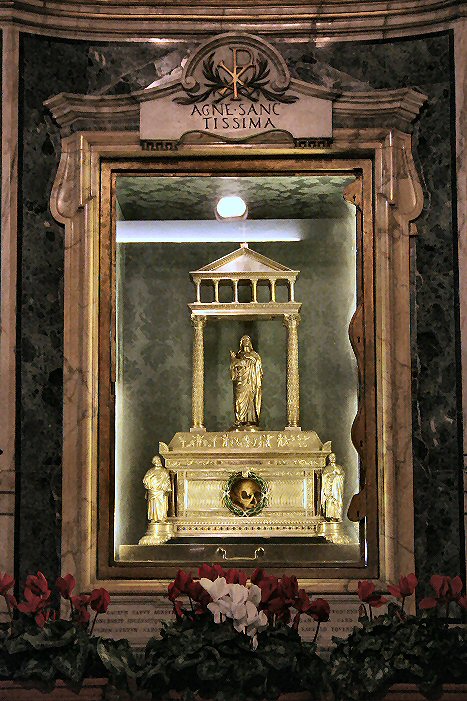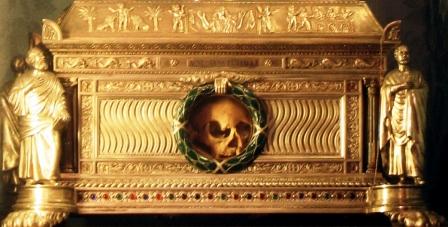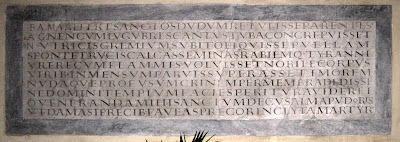Here is something I have posted in the past… about St. Agnes of Rome. Newcomers to WDTPRS may not have seen it.
 Behold the skull of Agnes.
Behold the skull of Agnes.

The dies natalis (“birthday into heaven”) of Agnes was recorded in the register of the depositio martyrum as 21 January.
St. Agnes was slain probably during the reign of the Emperor Diocletian in 304. Some say she died during the time of the Emperor Valerian (+260).
The little girl was buried by her parents in praediolo suo, on their property along the Via Nomentana where there was already a cemetery.
This cemetery expanded rapidly after that, because many wanted to be buried near the grave of the famous martyr. The ancient cemetery grew in stages between the Basilica which Constantina, daughter of Constantine and Fausta began over her tomb from 337-350 and the small round Basilica of Constantia (Constantine’s daughter).
There was an acrostic inscription from that time in verses about the dedication of the temple to Agnes:
Constantina deum venerans Christoque dicata
Omnibus impensis devota mente paratis
Numine divino multum Christoque iuvante
Sacravit templum victricis virginis Agnes…
You get the idea.
The Basilica of St. Agnes was reconstructed towards the end of the 5th c. by Pope Symmachus (+514). Honorius I (+638) rebuilt it as a basilica with three naves, adding a wonderful fresco of Agnes. It was worked on again in the 16th c. by St. Pius V and in the 19t h by Bl. Pope Pius IX.
h by Bl. Pope Pius IX.
Excavations in 1901 uncovered the silver sarcophagus made by Pius V for St. Agnes together with St. Emerentiana.
It contained the headless body of a young girl.
Zadock gave us a photo of the miraclous protection of Bl. Pius IX when once at the Basilica there was a near disastrous cave-in/collapse and no one was injured.
While Agnes’s body is in her tomb on the Via Nomentana, her skull is now at the place of her supposed martyrdom at the Piazza Navona in Rome’s heart. It is a fitting place to venerate a saint so much in the heart of the Roman people even today. It is not unusual for people to name their children Agnes in honor of this great virgin martyr, whose name is pronounced in the Roman Canon.
The skull was bequeathed to that church at the Piazza by Pope Leo XIII who took it from the treasury of the Sancta Sanctorum.
The Piazza itself was in ancient times the Stadium of Domitian (+96) a place of terror and blood for early Christians, far more than the Colloseum ever was. The Piazza is thus called also the “Circo Agonale” and the name of the saint’s church Sant’Agnese in Agone. “Navona” is a corruption of “Agonale”, from Greek agon referring to the athletic contests of the ancient world. St. Paul used the athlete’s struggle as an image of the Christian life of suffering, perseverance, and final victory even through the shedding of blood. Early Christian tombs often have wavy lines carved im the front, representing an iron instrument called a strigil, used by athletes to scrape dirt and oil from the bodies after contests. Victory palm branches are still used in the iconography of saints, as well as wreathes of laurels.
We know about St. Agnes from St. Jerome, and especially St. Augustine’s Sermons 273, 286 and 354. St. Ambrose wrote about Agnes in de virginibus 1,2,5-9 written in 377 as did Prudentius in Hymn 14 of the Peristephanon written in 405.
Ambrose has a wonderful hymn about Agnes (no. 8), used now in the Roman Church for Lauds and Vespers of her feast. The Ambrosian account differs somewhat from others. For Ambrose, Agnes died from beheading. Prudentius has her first exposed to shame in a brothel and then beheaded.
Here is the text of the hymn from the Liturgia horarum for the “Office of Readings” with a brutally literal translation.
Igne divini radians amoris
corporis sexum superavit Agnes,
et super carnem potuere carnis
claustra pudicae.
Shining with the fire of divine love
Agnes overcame the gender of her body,
and the undefiled enclosures of the flesh
prevailed over flesh.
Spiritum celsae capiunt cohortes
candidum, caeli super astra tollunt;
iungitur Sponsi thalamis pudica
sponsa beatis.
The heavenly host took up her brilliant white spirit,
and the heavens lifted it above the stars;
the chaste bride is united to the
blessed bride chambers of the Spouse.
Virgo, nunc nostrae miserere sortis
et, tuum quisquis celebrat tropaeum,
impetret sibi veniam reatus
atque salutem.
O virgin, now have pity on our lot,
and, whoever celebrates your victory day,
let him earnestly pray for forgiveness of guilt
and salvation for himself.
Redde pacatum populo precanti
principem caeli dominumque terrae
donet ut pacem pius et quietae
tempora vitae.
Give back to this praying people
the Prince of heaven and Lord of the earth,
that he, merciful, may grant us peace
and times of tranquil living.
Laudibus mitem celebremus Agnum,
casta quem sponsum sibi legit Agnes,
astra qui caeli moderatur atque
cuncta gubernat. Amen.
Let us celebrate with praises the gentle Lamb,
whom chaste Agnes binds to herself as Spouse,
he who governs the stars of heaven
and guides all things. Amen.
We can note a couple things from this prayer. First, the reference to fire probably a description of Agnes’s death related in a metrical panegyric of Pope Damasus about how Agnes endured martyrdom by fire. On the other hand, St. Ambrose, when speaking of her death, speaks of martyrdom by the sword.
 Pope St. Damasus composed a panegyric, an elogia, inscribed in gorgeous letters on marble (designed and executed by Dionysius Philocalus) in honor of Roman saints, including Agnes. This was the period when the Roman shifted from Greek to Latin. Damasus was also trying to make a social statement with these great inscriptions, set up at various places about the City. The panegyic of St. Agnes was placed in the cemetery near the saint’s tomb, but through the ages it was lost. Amazingly, it was at last rediscovered in 1728 inside the basilica, whole and complete: it had been used upside down, fortunately as a paving stone!
Pope St. Damasus composed a panegyric, an elogia, inscribed in gorgeous letters on marble (designed and executed by Dionysius Philocalus) in honor of Roman saints, including Agnes. This was the period when the Roman shifted from Greek to Latin. Damasus was also trying to make a social statement with these great inscriptions, set up at various places about the City. The panegyic of St. Agnes was placed in the cemetery near the saint’s tomb, but through the ages it was lost. Amazingly, it was at last rediscovered in 1728 inside the basilica, whole and complete: it had been used upside down, fortunately as a paving stone!
Now it is affixed to the wall in the corridor descending to the narthex. Its discovery was a find of vast importance (thanks to Zadok for the photo of the inscription).
FAMA REFERT SANCTOS DUDUM RETULISSE PARENTES
AGNEN CUM LUGUBRES CANTUS TUBA CONCREPUISSET
NUTRICIS GREMIUM SUBITO LIQUISSE PUELLAM
SPONTE TRUCIS CALCASSE MINAS RABIEMQUE TYRANNI
URERE CUM FLAMMIS VOLUISSET NOBILE CORPUS
VIRIBUS INMENSUM PARVIS SUPERASSE TIMOREM
NUDAQUE PROFUSUM CRINEM PER MEMBRA DEDISSE
NE DOMINI TEMPLUM FACIES PERITURA VIDERET
O VENERANDA MIHI SANCTUM DECUS ALMA PUDORIS
UT DAMASI PRECIBUS FAVEAS PRECOR INCLYTA MARTYR
It is told that one day the holy parents recounted that Agnes, when the trumpet had sounded its sad tunes, suddenly left the lap of her nurse while still a little girl and willingly trod upon the rage and the threats of the cruel tyrant. Though he desired to burn the noble body in the flames, with her little forces she overcame immense fear and, gave her loosened hair to cover her naked limbs, lest mortal eye might see the temple of the Lord. O one worthy of my veneration, holy glory of modesty, I pray you, O illustrious martyr, deign to give ear to the prayers of Damasus.
Damasus used the sources available. There were the stories told by her parents, the 4th edict of Diocletian against Christians in 304 (lugubres cantus tuba concrepuisset). Agnes did what she did of her own free will (sponte). Note the reference to the body as temple of God (1 Cor 3:16 and 2 Cor 6:16).
St. Agnes of Rome, has two grand churches in Rome. She has two feast days in the traditional Roman calendar. Since the reform of the calendar, Agnes now has only one day, alas.



































Actually, I think the “flames” and “fire” are still talking about the brothel. Fornax and fornix both get associated with fornicatio of the bad kind, and I seem to have read that some cut-rate places were near baker ovens (cheap heat at night, because the bakers started baking in the wee hours). Of course, this may be among the linguistic urban legends.
The basilica in the Piazza Navona is very beautiful. Whenever I take anyone to Rome for the first time, this is one of the first stops.
Is anyone else amazed at the fact that there is an 1800 year-old skull on display! Too cool!
If CCD teachers and home schooling mums would print out all your excellent articles on the Liturgy, the Lives of the Saints, and other Catholic meditations, they would do much better than using the nasty, pablum curricula out there. I just printed this out for my Father Z notebook.
Today, the erudite Anglican Father Hunwicke (may he swim the Tiber soon) in his erudite blog, Liturgical Notes, also comments on the Liturgy of the Hours hymn for St. Agnes day:
“Entertainingly, the ‘reformers’ who provided the texts of the Hymns for the Liturgia Horarum missed out four lines, explaining that they did so because the lines ‘nimis insistunt in praedicando pudore’ [they go a bit too far in preaching modesty]. What a lovely Sixties assumption: the idea that going on too much about sexual continence is a mistake*. One wonders if the ‘reformers’ ‘ studies and libraries provided views from their widows of the Sixties hotpants and miniskirts worn by the touristesses in the Roman streets outside. It would explain how Bugnini – whom I picture as a man with his mind set on higher things than knees – got away with so much liturgical dishonesty.”
If Father’s observation is typical of the fresh air that will be coming our way with the Ordianariate, I say, hear! hear!
That would be “Ordinariate,” of course.
By the way, where I live it is now, at this moment, minus 15 F. I have ice on the insides of all my windows and I am wearing a stocking cap inside. This meditation’s reference to the Piazza Navona reminds me of younger and warmer days in Rome having a lemonade, or a Campari, and a dolce outside a cafe there more than once. Of course, there is Bernini”s famous Fountain of the Four Rivers, with one river god holding his face up to shield his eyes from the ugly exterior of Sant’Agnese done by Borromini and Rainaldi, whose work obviously was not appreciated by Bernini. This could be urban, or rather of The Urbe, legend, as the facade was finished after the fountain, but Bernini probably saw the plans before-hand. How can anyone not love Rome?
RichR-Yes, I’m also amazed that a skull that old is on display for veneration! I second your ‘too cool’!
I always thought that the word ‘Agone’ in St. Agnes ‘in Agone’ on the Piazza Navone meant ‘agony’-you know, ‘St. Agnes in Agony’? I never got to visit either of her churches during my four visits to Rome.
Wonder if the traditional ‘blessing of the lambs’ will happen today? Those little creatures look so cute!
***this great virgin martyr, whose name is pronounced in the Roman Canon***
It is pronounced in the Roman Canon only if priests use Eucharistic Prayer I, which they hardly ever do. I’ve heard it used a few times in the last five years, but never once at the church we regularly go to. I guess it’s just too much trouble to take a few seconds longer to say the names of the martyrs. Consequently, these names, which were mentioned for over 1500 years are in danger of being forgotten. The Church saw fit to insert these names in the Roman Canon. Why do priests take it upon themselves to choose the option which leaves them out? (And why is there an option to do this, anyway?)
Thank you for this post. St. Agnes was one of my inspirations in choosing to become a consecrated virgin, so I sort of consider this as a personal feast day.
Perhaps you could ask your readers to say a prayer today for the post-Vatican II, restored Ordo Virginum?
I’ve been to the Sancta Sanctorum (not inside of course, just to the gate where you can peek in – at the top of the Holy Staircase across from St. John Lateran), and to the Piazza Navona as well!
Great post. I have re-posted it on my own blog. Thanks!
Will one of you Latin scholars please give me a translation of the Lauds Benedictus antiphon for St. Agnes in the FSSP Brevarium Romanum? I have nearly all of it, but I’d like some help!
Ecce, quod concupivi, iam video; quod speravi, iam teneo; ipsi sum juncta in caelis, quem in terris posita, total devotione dilexi. Thank you!
HyacinthClare,
Interestingly, it is identical to the one in the Liturgia Horarum. Lo, at last I see what I have desired; at last I hold what I have hoped for; in heaven I am wed to the very one whom I loved with complete devotione when I had been on earth.
That was my translation. Universalis has, “Behold, what I longed for, I now see. What I hoped for, I now have. On earth I loved him devotedly; now, in heaven, I am united with him.”
Behold, whom I desired, I already see; what I waited for, I already have (hold); to him I am joined in heavens, whom in this earth placed (understand as: whom I who having been placed here on earth) with total devotion I loved.
Thank you, gentlemen! I think I like Andrew’s… “whom I desired…” You all are much more efficient than my dictionary.
Fr. Z, thank you for this beautiful hymn and history (and for your great podcasts as well).
St. Agnes, pray for us!
My little patroness and my confirmation name: Agnese.
I wanted to be like her when I was confirmed at the age of 10: holy, pure, brave, and totally in love with Jesus Christ.
And I want to be like her even now as a much older person. St. Agnes, pray for me!
This hymn seems like a good possibility for the mutual enrichment spoken of in Summorum Pontificum. After reading your article, my heart sunk slightly to learn that all the hymns in the Roman Breviary are from the commons today. :P
Nannetteclaret: The name remains in the Roman Canon even if for some reason the Priest chooses to use one of those other Eucharistic Prayers. I’ve always figured that if the Roman Canon was good enough for Gregory the Great, St John Marie Vianney, St Pius V and X, Blessed Pius IX and John XXIII, it’s good enough for me. :)
In honor of our patronal feast, my Church History students here at St. Agnes in St. Paul have no homework for the weekend.
Wonderful post, Fr. Z.
What does it mean, she “overcame the gender of her body”? Is being female something that must be overcome? What does the writer mean? Doesn’t sound so great to me. [Consider for about 4 seconds what the writer may have meant by that while putting it in its historic context. Is it possible that because women are physically weaker than men, people in the 4th century considered women to be weaker than men in other ways?]
This sort of talk is a pretty common rhetorical trope in Latin stuff (pagan or Christian) when a woman is notably strong, courageous, victorious in battle, etc. Mind you, Roman ladies were not widely supposed to be weak of mind and purpose. Roman matrons were notoriously tough old biddies, and they raised tough young chicks. Nor was Roman literature slow to celebrate the virtues and bravery of women, though of course it often doesn’t do these things in a modern way. But they didn’t expect Roman women to act with the same levels of courage as a Roman man (who all were supposed to have spent twenty years in the legions, at least in Republican times). Obviously if one sex is all combat veterans and the other isn’t, you’re going to expect different things from them. (Though yeah, there were lots of sexist jerks in ancient Rome, which I’m sure you’ll take as read.)
“Superare” means that you do something over and above what would normally happen, or that you get the upper hand over somebody. So you could read this as that she conquered her body, poor Brother Donkey, and defeated the normal impulse of a little girl to freak out in a perfectly natural way if treated roughly. Or you could read it that she surpassed her own natural levels of womanly courage, and passed to a level of courage which ignored the sad stuff happening to the body and was given directly by Christ.
Eucharistic Prayer I is the Roman Canon.